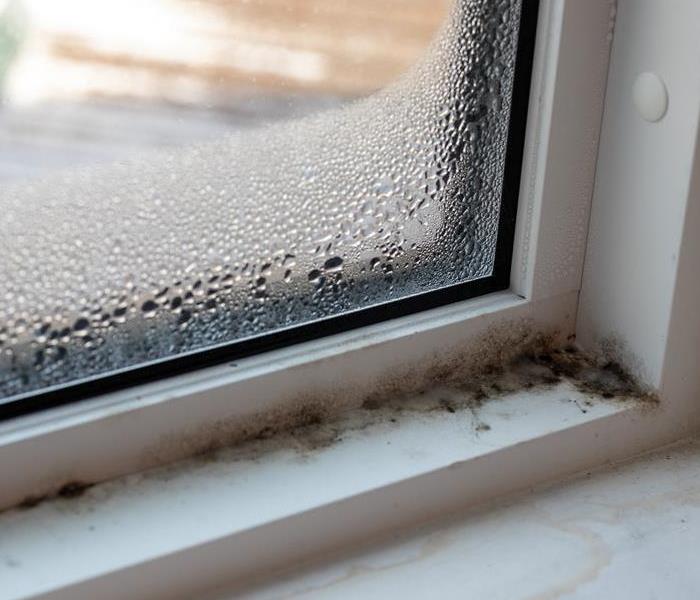Recent Posts
How to Deal with Mold in Your Home
2/5/2024 (Permalink)
Mold infestations can be a distressing discovery for homeowners. As a professional restoration company, we understand the importance of dealing with mold effectively. In this blog post, we'll provide you with a step-by-step guide, from a restoration company's perspective, on how to address and remove mold from your home.
Step 1: Identify the Source
Before you can effectively deal with mold, it's crucial to identify the source of moisture that is allowing it to thrive. Mold requires moisture to grow, so addressing the underlying issue is the first step. Common sources include leaks, poor ventilation, and water damage.
Step 2: Isolate the Area
To prevent mold spores from spreading to other parts of your home, isolate the affected area. Seal off the space using plastic sheeting and tape. Additionally, consider using an air purifier with a HEPA filter to capture airborne spores.
Step 3: Remove Contaminated Materials
Any porous materials that have been contaminated with mold, such as drywall or insulation, should be removed and properly disposed of. Mold can penetrate these materials, making thorough cleaning impossible.
Step 4: Clean and Disinfect
Use an appropriate cleaning solution to scrub non-porous surfaces where mold is present. After cleaning, use a disinfectant to kill any remaining spores. Ensure the affected area is completely dry.
Step 5: Repair the Source of Moisture
To prevent mold from returning, address the source of moisture. Repair leaks, improve ventilation, and make any necessary structural repairs to ensure that the area remains dry.
Step 6: Consider Professional Help
Mold removal can be a complex and labor-intensive process. If the infestation is extensive or if you have health concerns, it's advisable to seek professional help. Our teams have the expertise and equipment to handle large-scale mold remediation.
Mold removal is a task that should be taken seriously. Following the steps outlined above can help you effectively address mold infestations and create a safe and healthy living environment for you and your family. Call us at SERVPRO today to ensure that you get back to normal as soon as possible, like it never even happened.
Minimize Home Damage during Storm Season
6/12/2023 (Permalink)
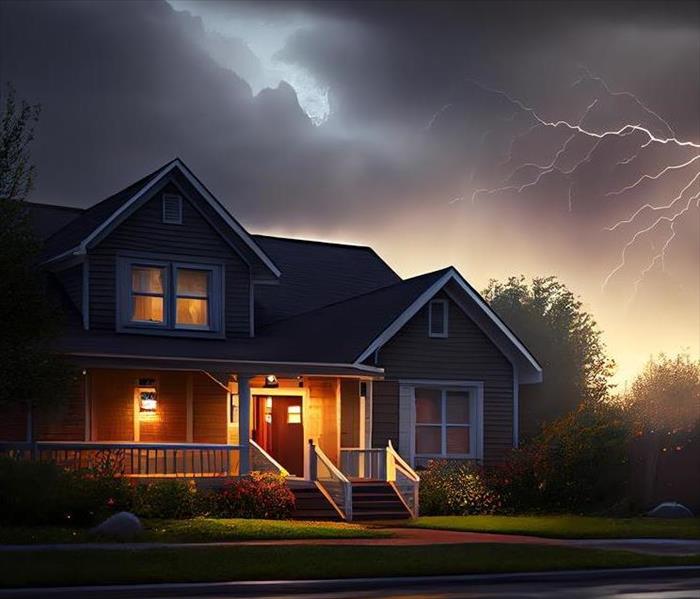 Prepare your home for summer storms.
Prepare your home for summer storms.
Storm season is upon us, which can make property owners feel unsettled and vulnerable. As someone once said, “Confidence comes from being prepared.” Perhaps you, too, lack the confidence of being prepared. As neighbors in your community, we want to help instill confidence that you’ve done everything possible to protect your home before the storm hits. As emergency responders for over two decades, we want to keep you informed by sharing our firsthand insight. Believe us- we’ve seen storm damage of all shapes and sizes. Either way, our #1 goal is for you to be able to enjoy your home as if it never happened!
So, how can you prepare? To ease any storm’s impact, we’ve compiled our go-to storm preparation recommendations just for you. Follow these tips to help reduce potential storm damage on your property and surrounding areas. You can thank us later. ;)
Storm Preparation 101:
- Look up. What trees and limbs are hanging over your property? Be sure dead or loose limbs are clear and trees trimmed. Also, look for trees with visibly shallow root systems and make sure nothing is within falling distance should the roots become saturated and the tree uproots.
- Look out. What is on your patio or lawn that could be blown by high winds? Make sure that any fences are secured, furniture anchored, and loose items are stored properly.
- Look around. Is the perimeter of your house secure? Are gutters draining properly? If not, be sure to clean out the debris to ensure proper drainage. Are windows and doors protected? If they appear vulnerable, consider covering them with plywood or installing storm shutters and even heavy-duty hardware.
- Look inside. Are the floors clear of belongings? Ensure books, electronic devices, photographs, and more are stored off the ground and not lying on the floor to incur potential water damage. Be sure to have a collection of drying materials (towels, rags, etc.) should you need to dry water quickly until help arrives. Also, make sure to have a proper stash of emergency items according to the CDC recommendations: https://www.cdc.gov/disasters/hurricanes/index.html
- Look at your phone. Who do you have stored in your contacts to call should any damage occur? Important numbers to have stored include friends and family, fire and police departments, health care providers and hospitals, local emergency management offices, utility companies, the American Red Cross, and emergency restoration and clean-up service of choice (three cheers for SERVPRO!). The #1 thing to remember is that a fast response will lessen the damage, reduce further damage and minimize costs.
Should any damages occur beyond your control, don’t forget that we’re your neighbors and already in the area. Our team can respond 24/7 to your storm damage restoration needs, call us - the locally owned and operated, certified professionals: SERVPRO of NW Charlotte, Lincoln County, Southern, and NE Gaston County.
We are available 24 hours a day, seven days a week, and dedicated to responding immediately. The quicker you call us, the quicker your home can return to normal.
What homeowners should know about flood insurance in North Carolina
6/5/2023 (Permalink)
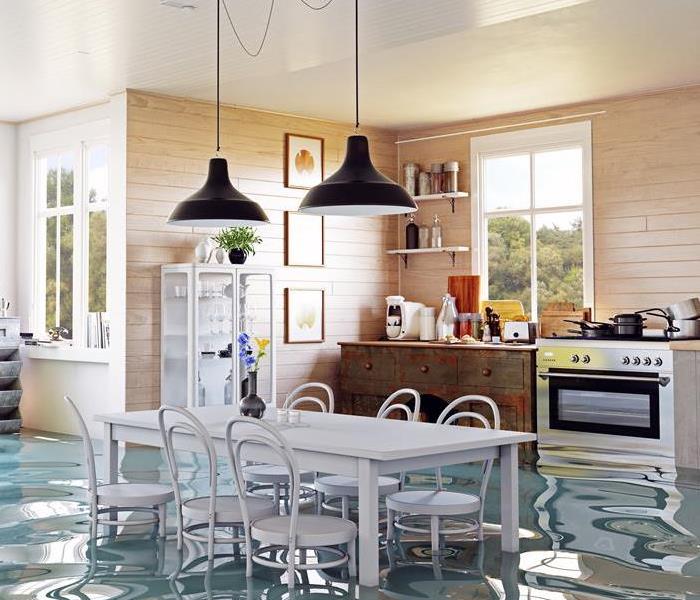 Does your home insurance cover Water Damage?
Does your home insurance cover Water Damage?
Are you Covered?
Am I Covered? The first question homeowners or renters ask themselves after suffering water damage - whether it’s flooding caused by a significant storm or brought on by firefighting efforts. And following a disaster or emergency, the insurance claims process can add more stress to an already overwhelming situation.
Fortunately, there’s a local resource to restore your home and help you navigate the insurance process: SERVPRO of NW Charlotte, Lincoln County, Southern and NE Gaston County. No property damage restoration project is too large for our highly trained and certified professionals, and we’re a preferred vendor for many insurance companies.
Adjusters understand SERVPRO’s goal is to provide customers with the best service (and peace of mind!) possible as we all work together. Our professionals provide 24-hour emergency response, quickly identify and mitigate damage, assess the loss, restore the damage, and develop a thorough electronic case file for customers and adjusters.
However, long before a disaster or emergency strikes, homeowners should understand the ins and out of their insurance policies so there are no surprises about what is - and what’s not - covered. Below are some North Carolina Department of Insurance responses to seven commonly asked questions about flood insurance.
1. Does my policy cover flood damage to my home and its contents?
Unfortunately, homeowner, renter, and tenant policies specifically exclude coverage for water damage due to flood, which is considered an “excluded peril.” Homeowners may purchase a separate flood insurance policy through the federal government. Note: Flood insurance isn’t just for properties in particular flood hazard areas; nearly 30 percent of flood insurance claims are for properties outside floodplains.
2. What is the National Flood Insurance Program (NFIP)?
In 1968, the federal government established NFIP. The Federal Insurance Administration, which is part of the Federal Emergency Management Agency, administers the program. NFIP makes flood insurance available to property owners in communities that help reduce further flood losses by adopting and enforcing floodplain management ordinances. Property owners must be within a city, township, or county participating in the NFIP by enforcing floodplain management standards. You only need to live in a participating jurisdiction - not in a flood plain - to be eligible to purchase flood insurance.
3. Am I covered for sewage backup in my basement if I added an endorsement to my homeowner’s policy?
Standard homeowner policies don’t cover water damage due to backup of sewer or sump pump; however, many companies will sell this coverage through a separate endorsement or addition to the basic policy.
4. If there’s seepage in my basement, do I have water damage coverage for the contents?
Standard homeowner policies don’t cover water damage caused by seepage through basement walls or floors, and there isn’t an endorsement available for this type of water exposure.
5. If I purchased special coverage for some of my personal property and then added it to my homeowner’s policy, are those items covered for flood?
Personal property items you can schedule for coverage in an endorsement to a standard homeowner or tenant policy include Jewelry, computers, cameras, musical instruments, silverware, golf equipment, fine arts, postage stamps, and rare collectibles.
6. Is there coverage for the fire damage on my flooded property?
Standard homeowner policies exclude flood as a covered cause of loss; however, it gives back coverage for fire, explosion, and theft in the event of a flood.
7. Receding flood waters left debris all over my property. Is debris removal covered?
Standard homeowner policies provide a certain amount for debris removal, but only if covered peril causes the loss. Since flood is not a covered peril, there would be no coverage.
Water damage cleanup and restoration
SERVPRO is locally owned and operated and is part of the Mecklenburg, Lincoln and Gaston communities. Our water damage repair and restoration technicians are employees, not contractors. They use advanced water damage inspection and extraction equipment to find and remove moisture quickly. To learn more, call us anytime at (704) 393-7890 or request help online.
Is Your Home Winter Ready?
1/11/2023 (Permalink)
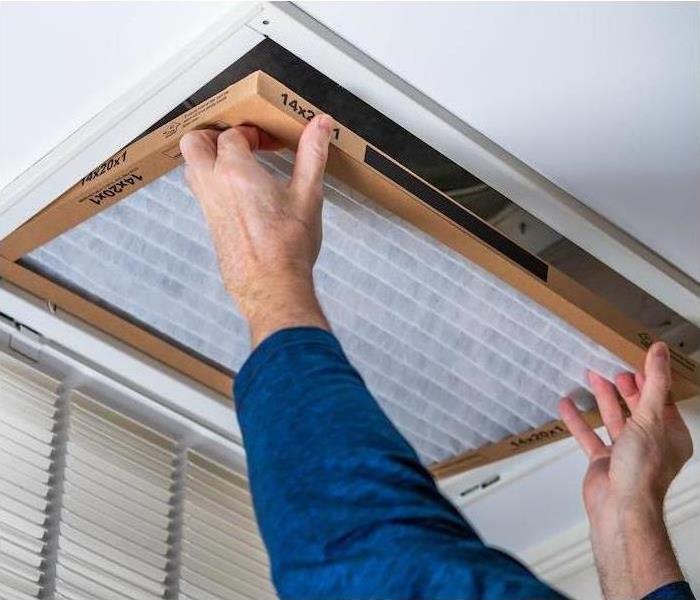 Get Your Home Winter Ready
Get Your Home Winter Ready
For those who live in the Charlotte area where weather events are typically mild, winter isn’t a season as much as it is a time for celebration. But friendly forecasts aside, as we move into the coldest months of the year, the city will still get its fair share of precipitation - whether it’s rain, snow, sleet or hail.
We’ll also experience a fluctuation in temperatures and an increase in days that dip into the low 30s and even below freezing - making it critical to get your home winter-ready. After a snow or ice storm, our restoration specialists see the aftermath firsthand: water damage caused by a burst pipe, gaping roof holes from falling trees, mold infestations in fireplaces, and smoke damage from a Christmas tree that went up in flames.
With so many North Carolinians spending more time at home than ever, we want to help you and family stay safe and warm, as well as protect your home from damage (both inside and out) all winter long. Just as Santa knows well the value of making a list and checking it twice, so should homeowners. The time to start winterizing is now - before the first storm or harsh weather event hits. Fortunately, you can DIY most of these home protection recommendations.
Indoor winterization tips
- Use pipe foam to insulate your pipes, especially those warm to the touch.
- Check and repair any attic, garage or shed leaks.
- Seal any water pipe or hose leaks.
- Be sure the temperature hot water tank is set safely, and clean your dryer vents.
- Seal the top of your fireplace if you don’t plan to use it during the winter.
- Change the batteries on any smoke and carbon monoxide detectors and make sure the equipment is working correctly.
- Replace filters throughout your house and open heating system vents.
- Flush your water heater to let any sediment run out.
- Install window insulation film and weather-stripping tape around doors and windows. For a quick fix, use a rolled-up towel or blanket to keep under door drafts at bay.
Outdoor winterization tips
- Clean your downspouts and gutters of any debris, twigs, leaves, nuts or rocks so ice can’t build up and clog them.
- Trim tree limbs around your home. When weighed down from wet snow or an ice storm, they can break or fall, causing damage to your roof, home, car or fence.
- Fill any siding and window cracks or gaps with caulk.
- Take out any window AC units and remove any debris, branches or leaves around your air conditioner condenser.
- Drain and disconnect hoses and turn off your sprinklers. If your pipes aren’t frost-proof, turn off the water valve by the spigot.
- Move outdoor furniture, grills and propane tanks away from the elements, or wrap them in tarps and bungee cords to keep them secure outside.
- Remove any moss or vegetation from your roof.
24/7 water damage and restoration assistance
American travel writer Paul Theroux said, “Winter is a season of recovery and preparation.” Unfortunately, sometimes preparedness is still no match for Mother Nature’s wrath or other cleaning or restoration emergencies. If that happens, you can rest assured our team is just a phone call away.
Although SERVPRO of NW Charlotte, Lincoln County, Southern and NE Gaston is part of a national network of 1,700-plus franchises, we’re locally owned and operated and part of the Mecklenburg, Lincoln, and Gaston communities. Our water damage and restoration experts are employees, not contractors, which means our team can respond faster to emergencies with a proven water damage restoration process and the most advanced technology and equipment. For questions, contact us anytime at (704) 393-7890 or request help online.
It's Time to Winterize Your Home
12/6/2022 (Permalink)
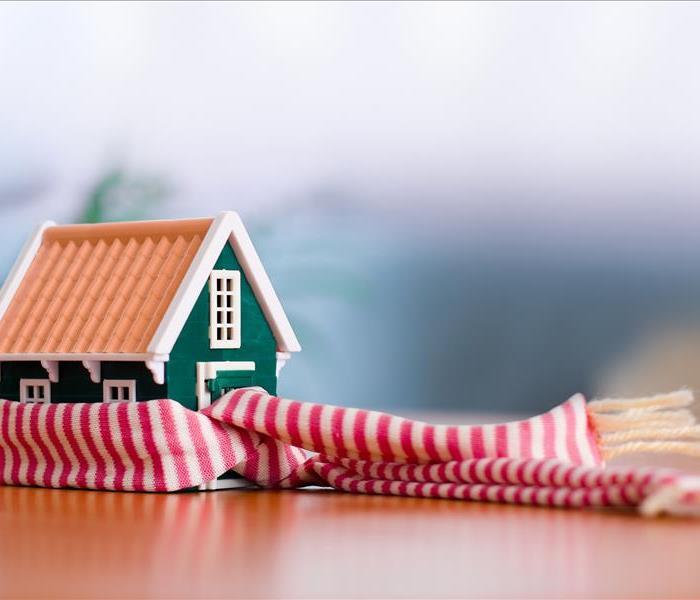 Winterize Your Home
Winterize Your Home
As temperatures are now cooler, have you taken the opportunity to make sure your home is effectively winterized? Winterization is not only the process of preparing and protecting a home or building from potentially freezing temperatures but also protecting it from the effects that such freezing temperatures could have including pipe bursts and water damage. Most structures are built to withstand the typical temperatures in which they reside. However, cold temperatures over a while can still test the ability to withstand such elements.
Make sure you’ve completed these quick and easy recommendations to prevent a temperature-related disaster.
- Turn up the inside heat temperature by a few degrees. Even though this may raise your utility bill a few dollars, it will save you the potentially large expense of disaster recovery.
- If the weather is calling for freezing temperatures, be sure to turn any sink, bath, and outside faucets to a drip to prevent them from freezing.
- Also if there is going to be freezing temperatures, open cabinets underneath sinks so that the heat can keep the pipes warm. You can also wrap your pipes in insulation for an extra measure of protection.
- Whether your home or business is occupied or empty, never completely turn off the heat. To prevent freezing or other damage, buildings need to be at least 55 degrees even if they are empty.
- If your home or business is in an older building, there is an increased risk of air drafts that allows the cold temperatures to enter. Be sure to block such drafts. Plastic winter insulation kits are available for drafty windows. Caulk or weather stripping can also help with drafts.
- Make sure that your vents can flow freely without being blocked by furniture or any other obstruction.
- Change your filters if needed to ensure your heat is working properly. Heat that is working improperly can be a risk for fire, carbon monoxide, and more.
- Make sure your fans are reversed to a clockwise rotation for them to rotate the warm air towards the ceiling downward and into the room.
- Be sure your gutters are free of leaves and any other blockages. Otherwise, excess water can freeze and cause unwanted damage to your property including water falling down the side of the house and saturating the ground around your foundation, along the walls, and in your basement. Also, Ice dams could cause major water damage to your roof, siding, and inside your walls.
- Replace any loose shingles on your roof. If the roof is exposed to rain or snow, your home is subject to water damage.
By taking these measures now, your property will be winter-ready for the elements of the season before disaster strikes.
However, should you suffer damages, we are available 24/7 - Call us at 704-393-7890.
House covered in scarf and toboggan
SERVPRO is Available 24/7 to Help you Restore Your Home After a Fire.
5/31/2022 (Permalink)
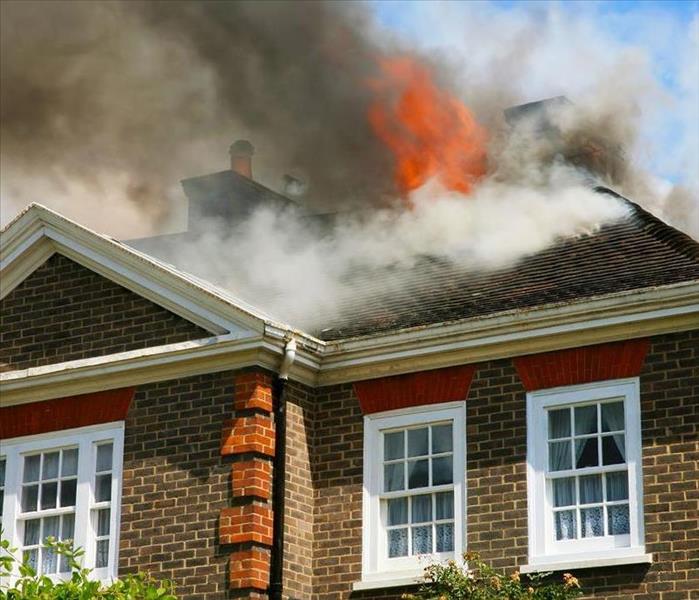 Home Fire in Charlotte NC
Home Fire in Charlotte NC
Most homeowners in Charlotte know that repairing and restoring their home after a fire takes time. The flames, smoke, and extinguishing agents left behind by the fire and first responders can leave your home in disarray. Do not let the mess intimidate you; instead, call a company certified to handle these situations.
Only a professional group can help mitigate your loss as it helps you salvage, remove, and restore your home and your personal belongings.
For our Charlotte and Mecklenburg County neighbors, fire damage restoration is a phone call away. Our SERVPRO team is available around the clock because we recognize that emergencies happen day and night. Our Green Fleet is ready to spring into action, assess the incident's impact, and create an action plan for your home. Our goal is to erase this disruption from your life by doing a conscientious and thorough job of restoring your home.
How do I decide what to keep and what to remove after a fire?
Looking at the soot sitting on your furniture, books, and decor may leave a hopeless feeling in your heart, but don't jump to conclusions until you consult our Damage Restoration experts. Our team has the expertise and solutions to restore documents, electronics, and flooring, among others. Fires also leave behind an acrid smell, which our team can address as well.
Our team at SERVPRO of Northwest Charlotte is here to help when you need it the most. Call us at (704) 393-7890 when disaster strikes and let us help you make your home, "Like it never even happened."
Flood Damage and Water: What's the Difference?
5/31/2022 (Permalink)
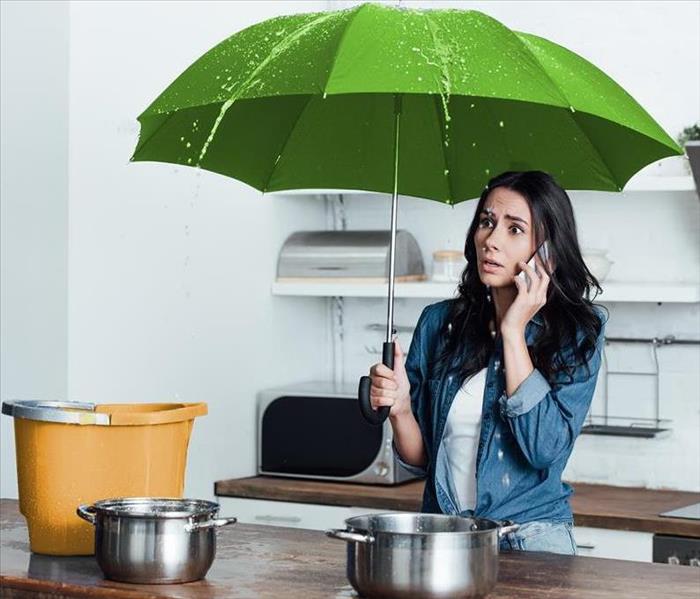 Woman in Charlotte NC home who is calling Water Damage Restoration Company.
Woman in Charlotte NC home who is calling Water Damage Restoration Company.
Is it Flood Damage or Water Damage?
Mitigation and restoration after water damage occurs is not the only piece of the water damage puzzle. When water causes damage, an insurance claim should be made as soon as possible.
Filing an insurance claim because of water damage can be complicated. The first step is knowing the difference between a flood damage claim and water damage. This information is crucial to the homeowner because it determines what is covered and what is not.
The distinction between a flood damage claim and a water damage claim is best be defined by (FEMA) the Federal Emergency Management Agency’s flood definition. According to FEMA, a flood is a general and temporary condition of partial or complete inundation of two or more acres and two or more properties of normally dry land.
To make it simple, if the water that caused the damage occurred from a natural source and any neighbors are experiencing the same water issues, its generally flood damage. According to FEMA, flood damage can only be caused by overflow of inland or tidal waters, unusual and rapid accumulation or runoff of surface waters from any source, mudflow, or collapse of land along the shore of a lake or similar body of water as a result of erosion or undermining caused by waves or currents of water exceeding anticipated cyclical levels that result in a flood.
If a flood has caused damage to your home, it is important to know if you currently have flood insurance through the National Flood Insurance Program, because home insurance companies do not offer coverage on flood damage. Having flood insurance is extremely beneficial to homeowners who think they might even have the slightest chance of being affected by a flood. The official site of the National Flood Insurance Program states that flood insurance policies cover physical damage to your property and possessions.
Everything from the actual building and its foundation to the refrigerator and the food inside of it is covered by flood insurance and will be taken into consideration when claims are filed. Flood insurance does cover basements and areas below the lowest elevated floor, but it depends on the flood zone and the date of construction. It is important to remember that flood insurance does not cover the sentimental value of any property, so be sure to remove any precious items such as photos, documents, or personal items that cannot be replaced as quickly as possible.
When water damage occurs in your home, did not originate from a natural source, and is not affecting any surrounding buildings, a water damage claim is necessary. Circumstances such as broken toilets, overflowing bathtubs, broken pipes, and b burst water mains are all grounds for water damage claims that should be filed by contacting your homeowners insurance company.
Working through the process of filing both a water damage claim and a flood damage claim can be confusing, and seem overwhelming.
If water damage does occur, SERVPRO of NW Charlotte can clean and restore your home to make it "Like it never even happened." Call us 24/7.
Have Fire or Soot Damage in Your Home?
5/31/2022 (Permalink)
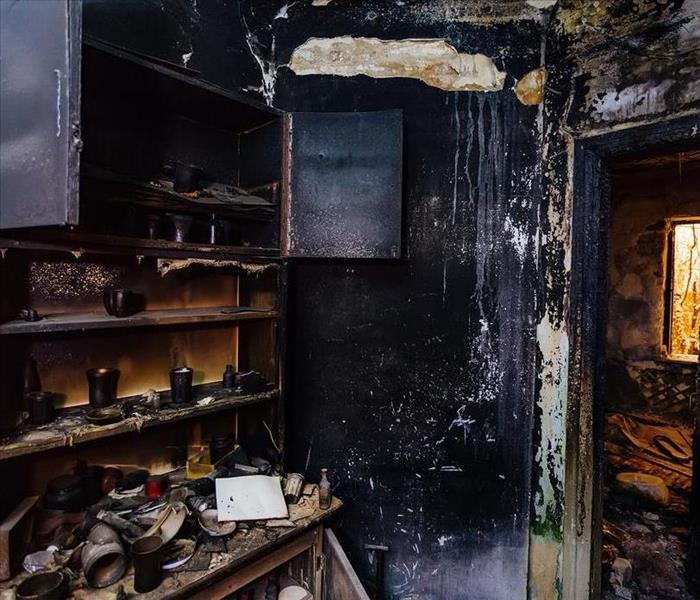 Fire Damage Room in Charlotte NC Home.
Fire Damage Room in Charlotte NC Home.
After a home fire, owners commonly find soot on walls, ceilings, and on other materials or objects. Most wall surfaces are porous, this includes brick, painted walls, and wallpaper,. Soot consists of very fine particles that can deeply penetrate into porous surfaces. Soot can causing hard to remove stains and lingering odors throughout your home.
Generally, it's possible to remove soot from walls and ceilings, but in serious cases, it may be necessary to remove, and reinstall affected materials like drywall and wallpaper. It is recommended to, to hire a professional restoration firm to get the best outcome from soot clean up after fire damage in your residence.
SERVPRO of NW Charlotte’s fire restoration experts are trained and equipped to handle smoke, ash, and soot cleanup process quickly and effectively. We begin soot cleanup by removing most of the dry soot using commercial grade high efficiency dusters, HEPA vacuums, and cleaning equipment.
For help in removing soot from your fire damaged home, contact SERVPRO of NW Charlotte at (704) 393-7890.
Home Water Damage typically starts in the Bathroom
5/31/2022 (Permalink)
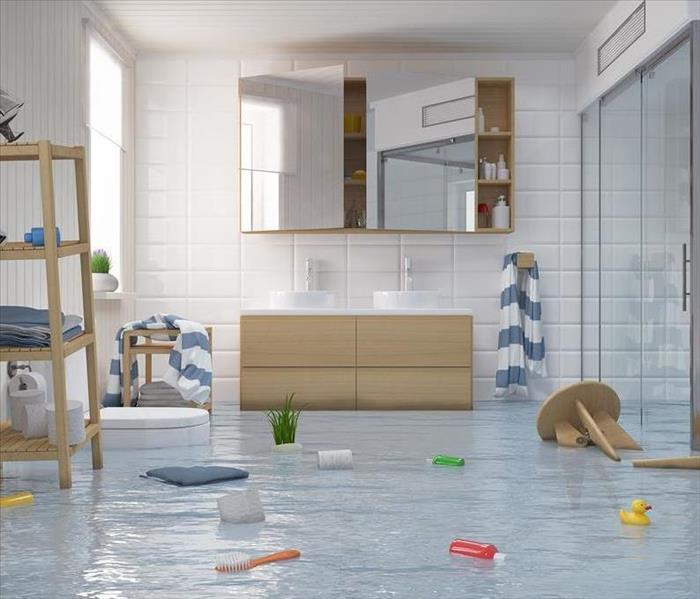 Bathroom Water Damage
Bathroom Water Damage
Many instances of the flooding and other water damage experienced in homes start in the bathroom. Bathrooms are a common source of water damage which can be created by overflowing toilets, overflowing sinks, under sink pipe bursts, overflowing bathtubs or water pipe leaks underneath the flooring. SERVPRO of NW Charlotte has water restoration specialists to help recover from the water damage caused by any issue in your bathroom.
Finding the Source of Water Damage
While an overflowing bathtub or toilet is never expected. Home owners are usually immediately aware when the water damage happens, unless they aren away at the time of the flood. Sometimes leaks can happen behind the walls of bathrooms that can go on for days, weeks or even months without being identified until the damage is significant. Water damage in bathrooms can cause considerable damage and mold growth. Visible issues can even go undetected if the owner is away from the home for a significant amount of time. In some cases, an unexpectedly high water bill can alert a homeowner something is wrong. Bathroom water damage of any type needs immediate professional attention.
What to Do After Your Bathroom Floods
While you’re waiting for water damage mitigation company to arrive, here are a few water damage tips:
- Remove excess water by mopping and blotting.
- Wipe excess water from furniture after removal of tabletop items and lamps.
- Remove and prop up wet cushions and upholstery.
- Remove wet area rugs..
- Turn air conditioning on for maximum drying in summer.
- Remove colored rugs from wet carpeting.
- Remove important objects to a safe, dry area.
What Happens When Water Damage Specialists Arrive
When the a water mitigation company arrives, they get to work to immediately assess the damage. They’ll inspect the damage and make an assessment in order to rectify the situation. Next, they’ll use advanced equipment to extract the water using pumps and vacuum units to rapidly remove water from your bathroom and surrounding impacted areas, which helps prevent further water damage and mold growth.
Then comes drying and dehumidification to help prevent odors and mold from growing.
Next, they’ll clean all the restorable items and structures damaged by the water as well as sanitizing treatments to remove odors and deodorize your property.
Finally, there’s restoration - restoring your home to its pre-damage condition. Restoration might include minor repairs like replacing drywall, tile floor repair, painting, or installing new baseboards in your bathroom. More significant repairs may include tarping, boarding up, packing, and moving, or other repairs.
SERVPRO of NW Charlotte can simplify the restoration process by handling the initial water damage mitigation and rebuilding the affected areas that will bring a building back to full functionality.
Bathrooms are a common area when it comes to water damage and flooding but choosing the best water damage restoration company can make the recovery process easier.
Contact us at (704) 393-7890to get your water damage handled quickly and professionally.
How to Locate your Home Water Shut Off Valve
5/31/2022 (Permalink)
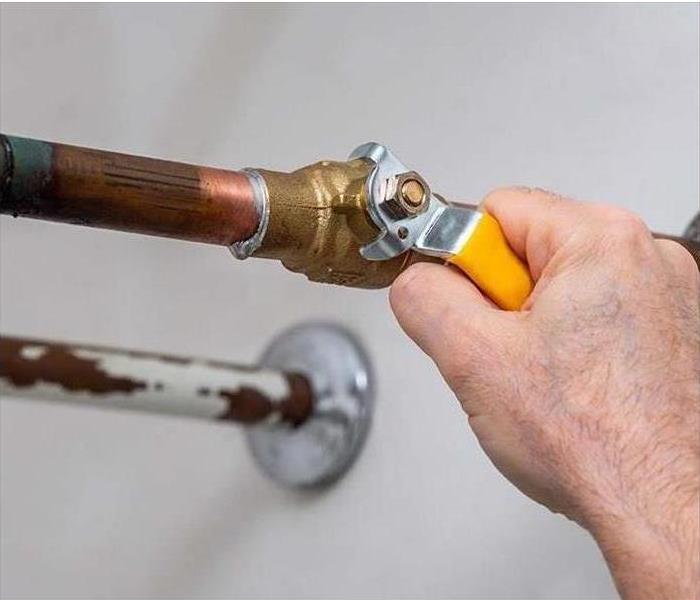 Man adjusting home water value shutoff.
Man adjusting home water value shutoff.
If the leak is from a sink or a toilet, it is easy to turn off the water for that line by turning the valve that is located beneath or beside the fixture.
What if you're not sure where the leak is coming from? It could be a pipe behind your wall, under your home, or somewhere that is hard to locate. In this case, you should turn off the water to the whole house. This means locating the water main shutoff.
Do you know where the shutoff is located and could you locate it in the case of an emergency? If not, don't feel bad. Many people do not know where to locate their water and gas shut offs.
Typically, these shut offs lie on the exterior of the home around the perimeter of the building. Once you have found the shut off, make sure that all members of your household know where it is. This is exactly why we tag these main shut offs during the creation of an ERP. The quicker you are able to turn off the water, the less damage is caused.
Once located, you can add water and gas shut off tags to the appropriate shut offs. You can add these tags as a helpful reminder if you ever have an emergency in your home. For example, if a leak happens or a pipe bursts in your home, the first thought to cross your mind should be to turn off the water.
Next step? Call SERVPRO of NW Charlotte.
If you experience water damage in your home, whether from a busted pipe, leaky roof, or natural occurrence, call SERVPRO of NW Charlotte at (704) 393-7890.
We are here to help 24/7.





 24/7 Emergency Service
24/7 Emergency Service
